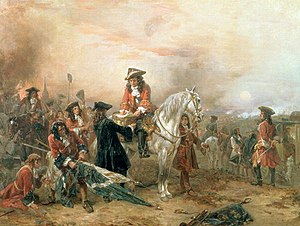Battle of Blenheim
| Battle of Blenheim | |||||||
|---|---|---|---|---|---|---|---|
| Part of the War of the Spanish Succession | |||||||
 The Duke of Marlborough Signing the Despatch at Blenheim. Oil by Robert Alexander Hillingford. |
|||||||
|
|||||||
| Belligerents | |||||||
|
|
|
||||||
| Commanders and leaders | |||||||
|
|
|
||||||
| Strength | |||||||
| 52,000 men, 66 guns |
56,000 men, 90 guns |
||||||
| Casualties and losses | |||||||
| 4,542 killed, 7,942 wounded |
20,000 killed, drowned, or wounded, 14,190 captured |
||||||
![]() England
England![]() Scotland
Scotland![]() Holy Roman Empire
Holy Roman Empire
The Battle of Blenheim (also the Battle of Blindheim and referred to in some countries as the Second Battle of Höchstädt), fought on 13 August 1704, was a major battle of the War of the Spanish Succession. The overwhelming Allied victory ensured the safety of Vienna from the Franco-Bavarian army, thus preventing the collapse of the Grand Alliance.
Louis XIV of France sought to knock Emperor Leopold out of the war by seizing Vienna, the Habsburg capital, and gain a favourable peace settlement. The dangers to Vienna were considerable: the Elector of Bavaria and Marshal Marsin's forces in Bavaria threatened from the west, and Marshal Vendôme's large army in northern Italy posed a serious danger with a potential offensive through the Brenner Pass. Vienna was also under pressure from Rákóczi's Hungarian revolt from its eastern approaches. Realising the danger, the Duke of Marlborough resolved to alleviate the peril to Vienna by marching his forces south from Bedburg and help maintain Emperor Leopold within the Grand Alliance.
...
Wikipedia
